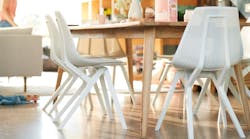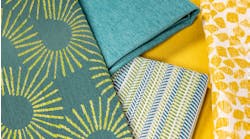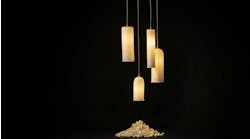A 2018 study published in Scientific Reports found that 46% of the plastic waste in the Great Pacific Garbage Patch—the giant waste gyre between California and Hawaii—came from fishing nets. To reduce and recover waste like this found in the oceans, companies are rethinking the materials they use to create interior design elements like furniture, textiles and flooring. New furniture company noho is one manufacturer utilizing these upcycled fishing nets and plastics to create pieces like its first chair: noho Move.
The noho Move chair is predominantly made from ECONYL regenerated nylon, a material made by Aquafil from recycled plastic waste stream materials such as reclaimed fishing nets and end-of-life carpet. noho co-CEO Richard Shirtcliffe says he was inspired to use sustainable practices during a family trip to Indonesia, when he was struck by how much plastic waste was washing around his family as they learned to surf.
[Related: Aquafil Creates Better Way to Recycle]
“Horrified and moved, I started dreaming of how we could battle the issue and ultimately eradicate plastic waste,” Shirtcliffe states.
Ergonomic and Eco-Friendly Design
He joined forces with Formway Design to create noho, a direct-to-consumer lifestyle brand that makes furniture to improve the health of users and the planet.
“Our designers, sister company Formway, have been pioneers in dynamic comfort, especially in premium commercial seating, for decades—designing legendary products like the Life and Generation chairs for Knoll,” says Shirtcliffe.
The noho Move chair is the company’s first product, launching in April. The material with which the chair is made gives the base and back flexibility that allows it to move with the user’s body, hence the product’s name. Shirtcliffe notes that while traditional chairs are static or simply rock, “noho Move is designed to rock and flex with anybody, freeing sit bones, spine and femoral artery of comfort-killing, health-diminishing pressure points.” he says.
The modern chair is ideal for offices, education, hospitality and residential spaces, since its ergonomic features support all the demands and realities of life. The company is looking to add other pieces that similarly support a dynamic lifestyle while also embodying the company’s commitment to using sustainable, upcycled materials.
“Companies switching to eco-friendly methods when crafting new products is crucial for the future of our planet,” Shirtcliffe says. “Creating a new product out of upcycled waste has not been simple…it would have been much faster, cheaper and easier to create an equally beautiful chair out of virgin plastic. But at what cost to the planet?”
Drawing Inspiration From Heritage
Although noho is based in Boulder, CO, Shirtcliffe says histhe company’s New Zealand roots are highly reflected in the company’s its values and design practices.
While he moved his family to Boulder last year, Formway Design remains in New Zealand where the chair is produced.
“In New Zealand’s indigenous language, Te Reo Maori, ‘noho’ means to sit, stay, dwell and live, and that is exactly what noho has set out to help people do better,” he explains. “noho is out to challenge the status quo and change things for the better by creating quality furniture that doesn’t compromise when it comes to comfort, style or our earth.”
See how the noho Move chair breaks down below.
- 9 pounds of recycled plastic found in each noho Move
- 100% recyclable packing materials and 0 plastic used
- Comprised of 75% ECONYL and 25% recycled post-industrial waster polypropylene
- 80%+ renewable energy powers noho’s production in New Zealand
- 5 years and 100+ prototypes to develop the final noho Move
- 100% waste material goes into ECONYL creation, with a minimum certified of 50% from post-consumer waste
Read Next: Econyl-Nylon Reduces Carpet Impact Waste



